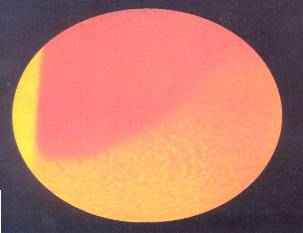I saw the yolk,
The air pocket, and eggshell.
It was cool.
The air pocket looked like a little white pillow.
The yolk looked like a yellow crayon.
And the eggshell looked like ripped up paper.
Michael, Grade 1, Mr. D.
April 2002
View pictures of candling below.
Egg Candling:
Eggs viewed from the side in a dark room while being illuminated from below.
Fresh eggs appear clear with no shadows. Infertile eggs may also look like this or like the one week photo when a torch is held at the air gap end after 10 days. |
 One week: The upper 1/5 of the egg appears darker. The embryo is 10mm and has blood vessels and starts developing limbs. |
 Two weeks. The upper one third of the egg is dark. The blood vessel network and the amniotic sack enclosing the embryo cover the upper part of the yolk. All body organs are present, eyes are visible from day 8 and the beak begins to develop towards the end of week 2. |
Three weeks. The upper half of the egg is dark. The beak begins to harden and feather buds are formed. The air cell occupies about 16% of the total egg length. |
Four weeks. The upper dark part of the egg extends around the air cell from as early as day 21.Feathers are forming and nails on toes .The embryo turns so spine is parallel to the long axis of the egg. |
Five weeks. The entire egg except the air cell is dark. The egg white is entirely used up and the yolk begins to move into the body cavity through the chick navel. |
Five weeks. The embryos neck bends to the right above the right foot to attain the pipping position with beak pointing towards the air cell end. The air cell occupies about 22%. |
Day 39-42 (eggs in hatcher) The correctly positioned chick pips internally by breaking through the air cell membrane. External pipping occurs between 12-24 hours after internal pipping. |
It may take another 12 hours after making an external hole for the chick to break free. It uses a combination of kicking, pecking and body movements to achieve this. |
Some common problems: If chick has not externally pipped after 12 hours of internally pipping then a hole will need to be made in the air gap end to ensure enough oxygen. Use a heavy sharp instrument and give a short tap. Empty out chips to avoid cuts. Sometimes the external hole ends up as a circle with no running cracks.If this happens and they are making no progress after 8-12 hours then YOU MAY HAVE TO HELP THEM OUT. If the external hole is low on the egg then you may need to tilt the egg up to stop fluid building up in the chicks head. |
| HOME:new
zealand farmstays |
|
